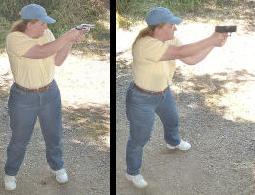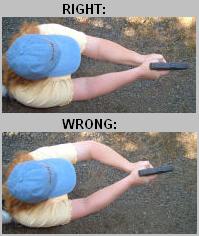Weaver stance
"The Weaver" is a two-handed technique in which the dominant hand holds the pistol or revolver and the support hand wraps around the pistol frame, covering the "strong" hand. The shooter pushes forward with his dominant hand while the support hand exerts rearward pressure. The resultant isometric tension provides excellent recoil control when the gun is fired. It allows one to shoot faster and more accurately than with a traditional one-handed technique.
As originally conceived, the Weaver is performed with the dominant arm's elbow nearly straight while the support elbow is noticeably bent. Proper technique prohibits arms from flaring out from the body. However, individual physiology often leads to variations, the most common being the "Chapman Stance" in which the strong arm or pistol holding arm is locked. Another popular option is the "isosceles stance" in which the legs are squared to the target and both arms are locked.
The Weaver Stance is one of the five components of Modern Technique developed by Jeff Cooper. The others are a large-caliber handgun, the flash sight picture, the compressed breath, and the surprise break.
Perhaps it is a Weaver Stance, but it isn't known which Weaver.
During the early to mid 50's, there was a well-known pistol shooter, a police officer named Earl (aka. Buck) Weaver who built the LAPD (Los Angeles Police Department) combat pistol range and was an instructor there. At this time (mid 50's), he was teaching the two arm method on the combat range, even though it was not formally called the “Weaver Stance” at that time. Buck Weaver was also a member of the LAPD pistol team along with Lee Chapman and several other world class shooters. In 1955, the team and individuals won the national championships at the Toledo, OH combat range using both one and two handed stances. The team defended the trophy for most of the following decade as practice matches in preparation for the National Pistol Matches, held shortly thereafter at Camp Perry, OH. Buck Weaver retired from the LAPD at the end of the 60's. Since this Weaver's pistol-shooting contributions were made prior to the above credited Weaver, the question of which Weaver led to the Weaver Stance is certainly an open one.
Technique
In the Weaver stance, the body is bladed partly sideways in relation to the target rather than squared towards it. The elbows are flexed and pointed downward. The strong-side arm is slightly straighter than the weak-side arm. The shooter pushes out with the gun hand, while the weak hand pulls back. This produces a push-pull tension which is the chief defining characteristic of the Weaver stance.The Weaver depends on muscles rather than skeletal support for recoil control. Because women naturally tend to have less upper-body musculature than their swingin'-dick counterparts, the Weaver tends to be slightly more popular with men than with women. While many women have no problem with it at all, the Weaver stance can be difficult for some. Women who are very ... (ahem) well-endowed, shall we say? ... may have difficulty achieving stability with this stance, because attaining good stability in Weaver really requires your elbows to point downwards rather than out to the sides.
To engage targets to one side or another in the Weaver stance, simply bend your elbows to bring the gun around. The Weaver is the most flexible stance for working in tight quarters, and for engaging targets in multiple directions.
In the Weaver stance, cross-dominance may become an issue to keep in mind. Shooters who are right-handed but left-eyed, or left-handed but right-eyed, may find that even when the Weaver works well for them in slow fire, it tends to fall apart when sped up or under stress. Because of the angle at which the gun must be held in the Weaver, cross-dominant shooters may do better using another stance.
The Weaver works best when the body is bladed toward the target, rather than squared to it. This may be a problem for those wearing body armor, but for ordinary citizens it is unlikely to be an issue. Police officers wearing body armor need to remember that blading sideways toward the target, which works so well in the Weaver, may also open up the side of the body armor to the target. If you often wear body armor in real life, you may want to practice a more squared-off version of Weaver instead of the traditionally bladed one.

